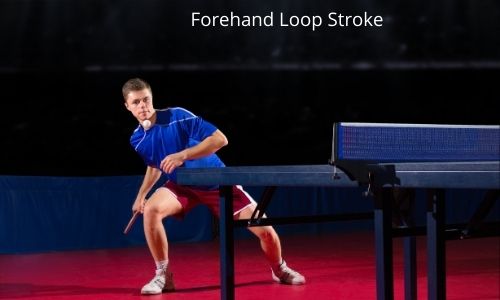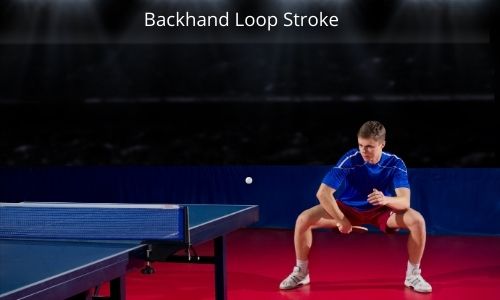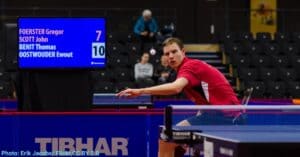Table tennis loop stroke is learning for those who have upgraded from beginner to intermediate level of play. Before approaching to learn the table tennis loop stroke you have to ensure that you have successfully covered the skills mentioned.
- Basic table tennis strokes, i.e. backhand push, forehand drive, backhand drive, and forehand push
- Concept of spin in table tennis
- How to serve in table tennis
Let’s come to the discussion of the loop, your lethal weapon in table tennis.
What is a Loop in Table Tennis?
Loop is a very powerful offensive stroke. It is a heavy topspin drive that involves the flexible wrist for brushing the ball with an upward and forward movement. Loop is of two types, the forehand loop and backhand loop that force the ball to dip and skid off the table with high speed.
In a topspin shot, when you brush at the top of the ball with your racket, the top surface of the ball moves faster than the bottom surface. For this, the top surface collides more with the air particle than the bottom surface which creates a high-pressure region at the top surface and low pressure at the bottom surface. Thus the resultant force acts downward forcing the ball to dip downward with a higher speed.
A loop is a heavy topspin stroke that involves more brushing action with higher racket speed than a drive.
What are the Types of Loop?
There are two types of loops in table tennis.
- Forehand loop
- Backhand loop
The basis of the forehand and backhand loop is the forehand and backhand drive with an additional spin and speed.
How to Do a Forehand Loop in Table Tennis

In the forehand loop, your stance is side-on the table to give your bat the space for the swing and your bat faces the line of the play.
- Stand with your legs 1.5x apart from your shoulders.
- Your left leg should be slightly forward than your right leg (for right-handers) with a side-on stance.
- Be sure, to bend your knees to make the center of gravity low.
- When the ball approaches you, transfer the body weight to the right leg (for a right-hander).
- Rotate your trunk and then swing your racket from knee height to head height.
- During the stroke, transfer the body weight from the right leg to the left leg.
- The rotation of the trunk is very important in a looping shot.
- Keep your elbow higher than your wrist during the rotation.
- Your wrist has a very important role in a looping shot.
- Keep it flexible and give the last-minute slap to the ball to increase the amount of spin and speed.
- To counter a backspin ball with a looping shot, your racket should start from low with a less closed angle than to counter a topspin.
After hitting the ball, the follow-up of the racket should not cross the vertical centerline of your body. Otherwise, it will be difficult to come back to the ready position for the next shot, and your balance of the body will be disturbed.
If you are interested in video, check PingSkills for the great coverage on the forehand loop.
How to Play a Backhand Loop

In the backhand loop, your stance and bat should face the line of play.
- Stand close to the table with your legs 1.5x apart from your shoulders.
- Take a square-on stance on the table.
- Your wrist should be flexible.
- Your flexible wrist and forearm are the main anchors for the backhand loop.
- Your forearm should take an “L” shape with the upper arm and also with your flexible wrist.
- Bring your wrist back with the bat close to the left hip. (for right-handers)
- Swing your bat with an upward and forwarding motion all the way through.
- Your upper arm, forearm, and wrist, all should be in a straight line at the time of the completion of the stroke.
When you impart the backhand loop away from the table, you will get more time for your shot. At that time the rotation of your hip will be more to swing your racket through a greater arc.
How to Improve Forehand Loop in Table Tennis
To improve the forehand loop, you have to impart more speed and spin to the ball. And to do that you have to brush the ball with the proper racket angle and increase racket speed.
- Don’t hold your racket close to your body, it will prevent the swinging action of your forearm and wrist. Keep the racket apart from your body to allow the free swing.
- Don’t stretch your hand behind your body. Hold the racket beside you just above knee level and follow the bat up to the height of your head to create a powerful topspin. If you stretch your hand, the contact of the ball will also create a sidespin along with the topspin, not a powerful topspin.
- Your follow-up action should not cross the vertical centerline of your body.
- Always keep your wrist and lower arm flexible.
- Transfer your weight from the right foot to the left foot along with the rotation of your body for more racket speed.
- Contact the ball at the top of the bounce because at that point your racket will cover the maximum distance which effectively gives you the maximum racket speed.
- Contact the ball at the top part of your racket where you will get more racket speed.
How to Improve Backhand Loop in Table Tennis
- Stand slightly apart from the table for the space required to swing your racket
- Synchronization of the movement of your racket and the lifting of your body is essential. You should start to lift your body as you start to swing your racket. Both actions end up with the completion of the stroke.
- Your wrist and forearm are the key elements of the backhand loop. Keep them flexible enough to create the proper brushing action to execute the topspin.
- Your grip should be loose enough to give the last-minute slap.
- Don’t change the angle of the racket during the stroke.
- Your racket should be at your knee level to maximize the length of the arc.
- Hold the racket with your flexible wrist facing backward, so that the top edge of the racket points towards your body for more brushing action with your backhand loop.
How to Play Backspin with Forehand Loop
To nullify backspin, you have to brush the ball with topspin. The more the backspin, the more topspin you have to generate with your brushing action.
- Bent your knees to make your center of gravity lower, so that the length of the arc of the swing is maximum.
- Make sure that you start with your bat beside you at your knee level.
- Your bushing action will be vertical, not forward to contact at the top of the ball for more topspin.
- The angle between the forearm and upper arm will be 90°.
- The angle of your racket should be close enough to counter the backspin.
- The follow-up action will end above your head, not crossing the centerline.
How to Play Backspin with Backhand Loop
To counter the backspin, you have to generate sufficient topspin by brushing at the top of the ball.
- Make sure that your bat is low enough to create the maximum swing with the upward movement of the bat.
- Your brushing action must be upward, not forward.
- Your wrist and lower arm must be flexible to create the maximum topspin.
- Your bat must be always well below the ball at the start of your brushing action.
What is the Difference Between Loop and Drive in Table Tennis?
Often the question is being asked regarding the difference between the loop and drives in table tennis.
Loop is the more powerful topspin where the focus is to get the maximum spin. Speed is the secondary aim of the looping stroke. But in Drive, the primary focus is the speed and the secondary focus is the spin.
The drive is a compact stroke to continue the rally, often cited as a counter-hit, and is taken close to the table whereas the loop is an attacking stroke that is taken away from the table.
The starting position of the racket in the loop stroke is much lower than the drive.
The heavy brushing in loop stroke makes the curved trajectory of the ball whereas, in the drive, the trajectory of the ball is almost straight.
The drive is the beginner’s learning whereas the loop is for intermediate and advanced level players.
Wrapping Up
The loop is a powerful offensive table tennis stroke. This stroke will help to bring a lot of points to your wallet during the match. So it is necessary for proper learning and execution of this stroke.
Related:



